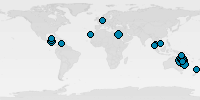
The steamer St Paul sank in March 1914 in front of Brisbane with a fully load of ore and with the loss of 18 lives.
| Name Dive Site: | St Paul Wreck |
| Depth: | 38-42m (124-137ft) |
| Visibility: | 5-50m (16-164ft) |
| Inserted/Added by: | bluezonescuba |
| Rated: | Rated not yet |
| Specifications: |     |
| GPS: | S27°00.25', E153°29.83' |
Send us your images for this dive site[Add Image][Add Movie]
In the late evening of March the 26th 1914, Captain George Corree, master of the Steam Ship Saint Paul approached Cape Moreton to the north-east of Brisbane. Conditions were fine, with a very slight sea running and good visibility. A study of the weather chart from that fine autumn evening would have an observer believe that a disaster at sea was almost impossible. The steam powered freighter of some 1660 tons was inbound from New Caledonia to Brisbane with 2800 tons of Chromium ore in her holds. The ore was intended for Europe and was to have been transferred to the SS Port Lincoln upon her arrival at the Brisbane wharves. At around eleven that evening Captain Corree ordered that a request for a pilot vessel be signaled to Cape Moreton Light Station, and that the ship be slowed to half speed to await its arrival. The Cape Moreton Light Station first sighted the Saint Paul about 9 miles east northeast of the Cape and a short time later was able to identify her by Morse signal. It was established that the Pilot Boat Llewellyn would soon be underway to assist her passage into Brisbane, and was making steam shortly after eleven o'clock. Moments after these transmissions were completed, the heavily laden freighter struck Smiths Rock. The ship's inertia relentlessly carried her forward against the jagged stone ripping and buckling her iron belly plates. By 12.40am the Llewellyn had arrived on scene and signaled to Cape Moreton that the Saint Paul had gone down. Reports from the survivors suggest that the damaged ship sank within minutes; however the fact that the ship now lies nearly 1000 meters to the east of Smiths Rock would indicate that it took some time for the flooding to be realized. Eleven people were rescued from the sea that morning, tragically however, 18 had lost their lives, including that of the Captain. It is interesting to note that almost all of the Engineering staff were amongst those saved. A few years earlier when the RMS Titanic sank, all of the engineers had perished. Perhaps knowing this, the engine room crew of the Saint Paul, were quick to assure that they did not meet the same fate by making an early escape.
The fact that so many lives were lost so close to a major port while good conditions prevailed outraged many people. No doubt that same outrage prompted the decision later that year to replace the black unlit buoy which marked Smiths Rock at the time of the tragedy, with a gas fired lit buoy, showing a light which would be seen from up to twelve miles distant.
The wreck of the Saint Paul now lies between 38 and 43 meters of water on a gentle sand slope due east of Smiths Rock. She sits in an upright position, favoring her port side, with the bow pointing westward to the rock that sent her there. Although deep enough to escape substantial damage from storms and cyclones, nearly 90 years on the sea floor have taken their toll on her remains. The superstructure and most of the hull plates have now rusted away, leaving the wreckage of a once fine ship collapsed on the sea floor. From a divers perspective this is a very challenging dive. The Saint Paul lies in an exposed area of sea, at the maximum depth limit for recreational "no decompression diving". With an air no decompression limit of approximately eight minutes, it's not possible to fully appreciate this wreck in just one dive. The wreck itself provides plenty to see if you take your time, from encrusted deck winches and lift raft anchors to nuggets of chromium ore, the careful observer is well rewarded. The wreck is alive with marine life and although it is common practice to dive her early in the day to escape the afternoon onshore winds, the life is more prevalent in the early evening when large schools of snapper and yellowtail kingfish seem to be settling in for the night .Underneath deck plates and around the bases of the engine and boilers, large estuary cod can be found lurking in the shadows. Like many dive sites the stakes go up when a slight current is prevalent, bringing these huge cod out and above the wreck to compete with the pelagic for any food coming down current.
[Add Message]Messages from readers:
[Add Divelog]Divelogs from members:
